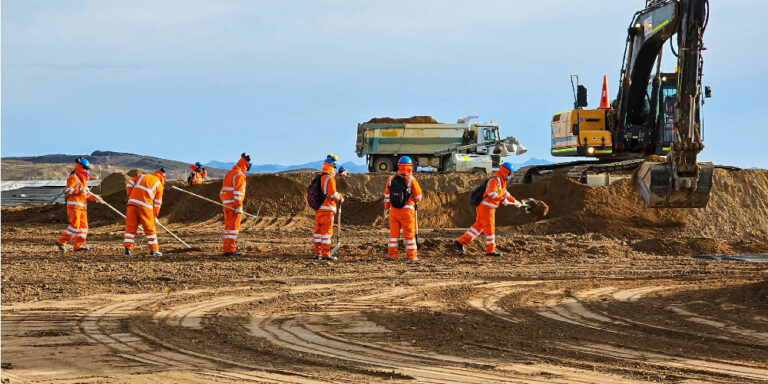— 9 min read
Earthwork Construction: Building Strong Foundations


Last Updated Aug 13, 2024

Stephen Abadie
Infrastructure Team Lead
Stephen Abadie is an Infrastructure Team Leader at RNGD. Stephen joined RNGD in 2015 as the Infrastructure Division’s Assistant Project Manager. Now, as Team Leader, Stephen uses his 17+ years of professional expertise in major infrastructure and civil construction to lead a team of 85+ employees in talent development, lean project delivery, and execution of production systems, delivering quality products for RNGD's diverse client base.
In his day-to-day, he directs his team on safety, quality, and production for all current and future projects. He enjoys leading a diverse group of personalities that span generations, learning from those with decades of experience, and mentoring the next generation of construction talent. A native of New Orleans, Stephen graduated from Louisiana State University with a degree in Construction Management.
Both construction and building relationships are his true passions, but when he’s not in the office or on-site, Stephen’s with family or spending time outdoors hunting or golfing. When he finds the time, he indulges in a good book or article about world history.

James Hamilton
Writer & Producer
85 articles
James Hamilton is a writer based in Brooklyn, New York with experience in television, documentaries, journalism, comedy, and podcasts. His work has been featured on VICE TV and on The Moth. James was a writer and narrator for the show, VICE News Tonight, where he won an Emmy Award and was nominated for a Peabody Award.
Last Updated Aug 13, 2024

Building foundations, road work, water and wastewater projects, levees, parks: Most major construction projects require earthwork. Earthwork is the process of moving and altering the soil, rock and other ground materials to prepare a site for construction or to finish a project.
Effective earthwork requires diligent planning, coordination between numerous stakeholders and a deep understanding of site conditions. Poor earthwork can lead to a variety of expensive and dangerous issues in the future, including cracked foundations, unusable roads, erosion problems or flooding.
This article explores the process, common considerations and best practices for earthwork construction.
Table of contents
The Basics of Earthwork Construction
From excavation to backfilling, earthwork is often one of the first and last things done on construction projects, ranging from building a single-family home to an airport. Moving, altering and processing soil, rock and other ground materials is a crucial part of preparing an area for construction or putting the finishing touches on a project to ensure it withstands the elements for years to come.
Earthwork usually involves a number of key stakeholders. Geotechnical engineers often analyze and classify the soil’s characteristics, strengths and ideal uses. Civil engineers usually use that data to design an earthwork plan, including site grading, drainage and the required specifications of a foundation. General contractors (GCs) who work in earthwork are often specialized in interpreting these plans, assessing unique characteristics of each site and working with the authority having jurisdiction (AHJ).
Most AHJs have specific requirements for earthwork and the earthwork permitting process. These processes might require special considerations based on a project’s unique environmental and geotechnical characteristics, such as its proximity to a body of water, urban area, or contaminated soil.
The type and extent of earthwork required for a project depends largely on the project’s size, intended use and location. Road construction in a place like New Orleans, which has minimal elevation change and is particularly close to rivers and wetlands, is a very different process from constructing a road in Colorado, which might have more dramatic elevation changes and is more likely to have drier soil and rock. Power plants need particularly stable foundations, as they often contain heavy equipment that complete intense processes such as pressurization, include dangerous chemicals and need to continue to function during storms and earthquakes.
Types of Earthwork
Earthwork includes a variety of tasks and activities. Here are some of the most common.
Clearing and Grubbing
Clearing and grubbing before construction or other types of earthwork. Clearing is the removal of trees, brush and debris. Grubbing is removing stumps and roots. Trees or other objects that are going to stay on site should be clearly marked.
Excavation
Removing soil and rock from a site. This is most commonly done to create an open face or hole that will be used for a building’s foundation or to install utilities beneath a roadway. Excavation also includes topsoil stripping and digging trenches.
Embankment Construction
Building up areas with soil or other materials to add elevation. Embankment is particularly important for projects that require a raised structure, such as roads, railways or levees.
Grading
Shaping the ground to create a level base or desired slope. Grading is particularly important for proper drainage, erosion control or creating flattened areas for parks, parking lots or foundations.
Backfilling
Replacing or adding soil to excavated areas. This might include replacing soil over utilities installed underground or adding soil around a completed foundation, retaining wall or culvert. Backfilling is crucial for the stability of structures, the safety of roads and erosion control.
Compaction
Altering soil to increase its density or strength. This is essential for creating stable embankments, backfilling or ensuring ground is strong enough to support a foundation.
Drainage Construction
Installing systems to manage surface and subsurface water, including ditches, culverts and drains.
Slope Protection
Stabilizing and protecting slopes. This can preserve the natural flow of water, ensure safe drainage and help with erosion control. Common methods include adding vegetation, geotextiles or riprap.
The Process of Earthwork Construction
While earthwork varies depending on the project’s location and intended use, there are common steps that usually need to take place.
Surveying and Assessment
Earthwork usually begins with extensive surveying and soil testing. This process usually identifies a site's characteristics, including soil type, soil quality, drainage patterns, moisture and potential environmental concerns. Areas where soil might need to be amended or stabilized should be identified. This might include methods such as proof rolling, which test the compaction quality of subgrade and base layers to identify soft spots or areas needing improvement.
Planning
Using data from surveys and soil tests, a civil engineer will often design the earthwork plan, including precise requirements for grading and excavation and designs for embankments, slopes and drainage systems.
Excavation often requires heavy equipment, including excavators, backhoes, bulldozers, scrapers or trenchers. Removing large or entrenched rocks can be particularly difficult and often times require blasting.
GCs create detailed plans for managing site logistics, including access to the site, equipment requirements and contingency plans for weather. GCs develops a timeline and detailed plans for excavating, altering, storing and transporting soil. Excavated soil usually either needs to be removed if it isn’t suitable for other uses or kept and stored for use in backfilling or landscaping. Usually, materials selected by the GC should be approved by the design team. Some agencies provide recommendations or have requirements for materials listed on their website, such as Minnesota’s Department of Transportation.
Project Execution
The GC oversees the execution of the earthwork plans. This usually includes site clearing, excavating, removing soils not suitable for use, relocating and compacting good soils in layers known as lifts, grading and altering soils with additives. Common additives, such as lime or soil cement, can help make the soil more stable and less likely to settle. At the end of earthwork, a site should be stable, cleared of debris, have proper drainage and be fully prepared for construction.
The GC and civil engineer both constantly monitor soil and external conditions and adjust tactics, when needed. Key factors include moisture levels, temperature fluctuations and unexpected variations in soil composition.
Inspections
Throughout the process, the GC and design team should be regularly conducting inspections to ensure the project is safe, meets design specifications and is likely to be able to handle extreme events in the future such as weather or earthquakes.
Stakeholders have a variety of field tests to help with inspections, such as the density test which verifies soil compaction against a proctor. The GC is usually responsible for providing documentation of all completed earthwork, as well as results of any inspections and information on materials used. In the case of road work or road maintenance, as-built drawings should be updated and approved by the AHJ.
Common Earthwork Considerations and Variables
There are many things that need to be considered in order to effectively complete earthwork.
Soil Type
There are many types of soil, including clay, silt, sand, gravel and organic matter. Each type of soil has a different capacity for building and will lend a different level of stability that will inform the work that needs to be done to create a suitable site. For example, clay soil tends to have high plasticity and swell when wet, which might require a lime treatment to increase stability and bearing capacity. Sand soil tends to drain well but has low plasticity. It can be used for certain applications.
Soil Quality
The soil profile helps determine the work that needs to be done to create a suitable site for building. For example, unstable or weak subgrade and soil can lead to settling foundations, roads, or settling utilities. Common alterations include adding lime to remove plasticity or cement to add stability. Some soil characteristics are particularly difficult and require extensive treatment, such as swelling clays, collapsible soils or loose sand.
Contaminated Soil
Identifying and handling soil that’s been exposed to chemicals or that may contain dangerous items is crucial for future users of the completed project, as well as the crews working in the field. Contamination is particularly common in sites located close to power plants, being built in historically significant areas or in areas with infrastructure that is many decades or centuries old.
Moisture
Moisture is one of the most important variables in earthwork. It impacts a soil’s ability to be compacted or amended properly. Crews should be monitoring the moisture of the soil throughout the project and, when necessary, processing the soil to make it drier or halting work until there are drier conditions.
Weather
Some of the greatest delays in earthwork are related to weather. Wet soil can be difficult to compact, dry spells can require plans to control dust, and freezing temperatures can cause the soil to expand/contract leading to voids. Intense rain or freezing can force work to stop completely. On roadways, some contractors will break work into sections to minimize the amount of soil exposed to the weather at any given time.
Erosion Control
Erosion control is crucial for both the efficacy of construction and the long term health of structures and roads. Identifying slope stability, moisture, weather patterns and soil density can help predict erosion and suggest effective techniques, which might include installing silt fences, sediment ponds or retaining walls.
Safety
Earthwork creates large, potentially dangerous holes and trenches and involves working with utilities such as gas, electricity and sewage. An effective safety plan usually includes regular meetings with important stakeholders, routine inspections and effective site logistics management.
Earthwork Construction Best Practices
There are a few habits and practices that usually make earthwork more likely to be successful.
Break work into phases.
Breaking down work into sections helps to help maintain ideal soil conditions. This limits the amount of soil that’s exposed to the elements at any given time, which can minimize risk of delays and rework and helps to respond to unexpected obstacles.
Manage documents.
Collaboration and communication in earthwork depends on the ability to store and share important documents, such as as-builts, Requests for Information (RFIs) or updated schedules. Digitizing these documents can help keep them organized and easier to share.
Use Geographic Information Systems (GIS)
GIS is a digital tool that uses maps to capture, store, analyze and visually share data and information related to specific locations. This can be particularly helpful with earthwork, as it can be used to assess site suitability, track progress and update as-builts.
Earthwork: The Invisible Trade
Earthwork is necessary for the creation of most of the modern world, including roads, towering skyscrapers and utilities. As vital as it might be, one of the defining characteristics of successful earthwork is that it’s invisible to most people who don’t work in construction. They don’t see or comment on earthwork when they’re driving down a smooth highway, living in a stable building or playing on a level field. However, they wouldn’t be able to do any of that without contractors and engineers having effectively completed a complex process of surveying, amending, excavating, grading and compacting the ground beneath them.
Was this article helpful?
Thank you for your submission.
88%
13%
You voted that this article was . Was this a mistake? If so, change your vote
Scroll less, learn more about construction.
Subscribe to The Blueprint, Procore’s construction newsletter, to get content from industry experts delivered straight to your inbox.
By clicking this button, you agree to our Privacy Notice and Terms of Service.
Thank you!
You’re signed up to receive The Blueprint newsletter from Procore. You can unsubscribe at any time.
Categories:
Written by

Stephen Abadie
Infrastructure Team Lead
Stephen Abadie is an Infrastructure Team Leader at RNGD. Stephen joined RNGD in 2015 as the Infrastructure Division’s Assistant Project Manager. Now, as Team Leader, Stephen uses his 17+ years of professional expertise in major infrastructure and civil construction to lead a team of 85+ employees in talent development, lean project delivery, and execution of production systems, delivering quality products for RNGD's diverse client base.
In his day-to-day, he directs his team on safety, quality, and production for all current and future projects. He enjoys leading a diverse group of personalities that span generations, learning from those with decades of experience, and mentoring the next generation of construction talent. A native of New Orleans, Stephen graduated from Louisiana State University with a degree in Construction Management.
Both construction and building relationships are his true passions, but when he’s not in the office or on-site, Stephen’s with family or spending time outdoors hunting or golfing. When he finds the time, he indulges in a good book or article about world history.
View profile
James Hamilton
Writer & Producer
85 articles
James Hamilton is a writer based in Brooklyn, New York with experience in television, documentaries, journalism, comedy, and podcasts. His work has been featured on VICE TV and on The Moth. James was a writer and narrator for the show, VICE News Tonight, where he won an Emmy Award and was nominated for a Peabody Award.
View profileExplore more helpful resources

Why do most construction strategies fail (and how to fix them)?
In this episode of The Power of Construction, hosts Sasha Reed and Brett King sit down with Helen Gawor, a strategist and transformation expert who challenges construction’s approach to strategy....

How AI Is Creating Big Advantages for Specialty Contractors
Every minute that an MEP contractor takes to file an RFI, untangle a scheduling knot, or search for a forgotten document is a minute spent not building something. Enter artificial...

How GCs Can Minimize Waste With a Strong Inventory Management System
Construction is a very fluid and fast-paced industry. Any given jobsite might have thousands of moving pieces, plus new items showing up on the loading dock day after day. In...

Construction Business Intelligence: From Data to Decisions
Leaders in the construction industry can now access a vast array of construction data through sophisticated construction business intelligence tools. Within this data lie insights that support daily decision-making and...
Free Tools
Calculators
Use our calculators to estimate the cost of construction materials for your next project.
Templates
Find a template to help you with your construction project tasks.
Material Price Tracker
Get the latest U.S. retail prices and view historical trends for common building materials.
Glossary
Explore key terms and phrases used in the industry.
